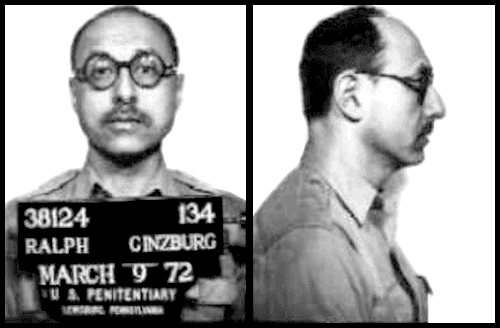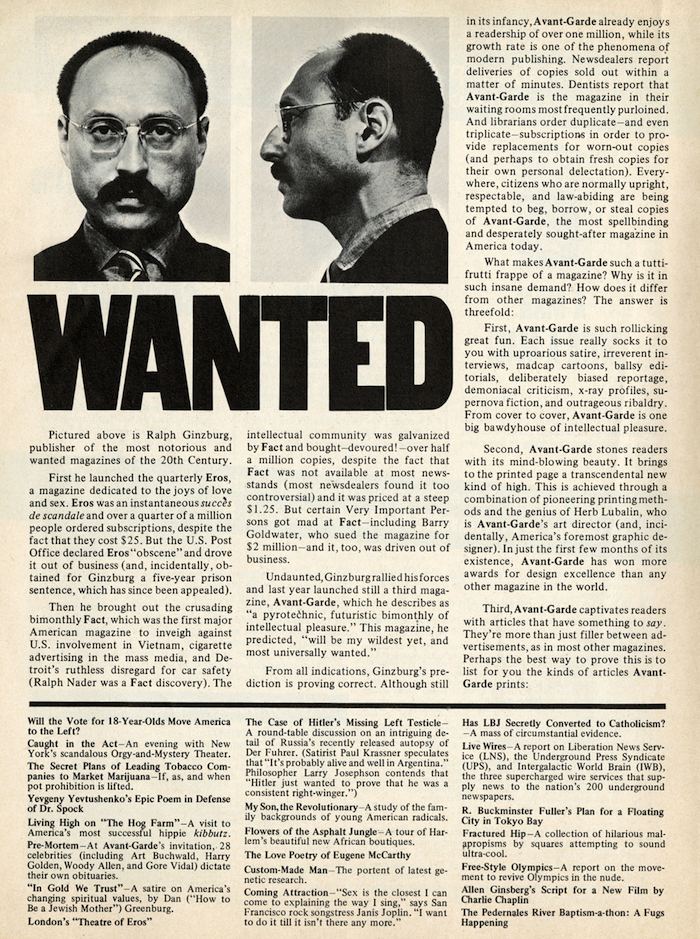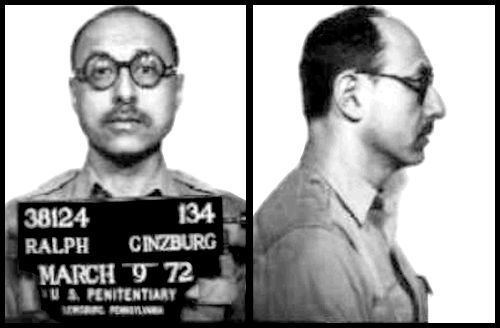Name Ralph Ginzburg Role Author | ||
 | ||
Died July 6, 2006, New York City, New York, United States Books 100 Years of Lynchings, An Unhurried View Of E, I shot New York, Castrated: My Eight Months in | ||
Ralph Ginzburg speaking at UCLA 9/30/1964
Ralph Ginzburg (October 28, 1929 – July 6, 2006) was an American author, editor, publisher and photo-journalist. He was best known for publishing books and magazines on erotica and art and for his conviction in 1963 for violating federal obscenity laws.
Contents
- Ralph Ginzburg speaking at UCLA 9301964
- AvantGarde Home
- Biography
- Eros Magazine
- No 1 Spring 1962
- No 2 Summer 1962
- No 3 Autumn 1962
- No 4 Winter 1962
- Prosecution for obscenity
- fact magazine
- Avant Garde
- Books
- Magazines
- Death
- References

AvantGarde Home
Biography

Ginzburg studied journalism and accounting at Baruch College of the City University of New York, was editor-in-chief of its campus newspaper, and on graduation in 1949 became a copyboy and cub reporter at the New York Daily Compass. Two years later he was drafted into the Army during the Korean War and assigned to Fort Myer, adjacent to Arlington National Cemetery, where he both edited the post newspaper, and took wedding photos for base marriages. While still in the Army, he worked at night as a copy editor for the Washington D.C. Times-Herald.

Upon discharge from the Army he shifted into broadcasting and magazines, working for Esquire magazine, NBC, Reader's Digest, Collier's, LOOK and, as he put it, "other pillars of communications industry respectability". He finally saved enough money to rent his own office — a fifth floor walkup in an old Manhattan office building.

His first publication was An Unhurried View of Erotica (New York: Helmsman Press, 1958). This rather scholarly-seeming book explored an ostensible undercurrent of pornography that runs throughout English literature. Beginning with a manuscript given by Leofric, Bishop of Exeter, to his cathedral in 1070 through the outright pornographic work of the 1950s, An Unhurried View examines examples of English erotic literature in an interpretive and explanatory context. The end of the book includes a bibliography of 100 titles. He convinced the notable psychoanalyst Theodor Reik to write the introduction.
In 1962, Ginzburg managed to conduct an extensive interview of 18-year-old Bobby Fischer, in what was to be practically the last formal interview Fischer ever gave. He sold the interview to Harper's Magazine, which published it in January, 1962, entitled "Portrait of a Genius As a Young Chess Master". The interview of the reclusive chess genius continues to have popularity.
In 1968, Ginzburg signed the “Writers and Editors War Tax Protest” pledge, vowing to refuse tax payments in protest against the Vietnam War.
Ginzburg was a vocal opponent of the practice of circumcision. He authored dozens of books and other publications, the last of which was I Shot New York, a book about photojournalism.
Eros Magazine
In 1962, Ginzburg began publication of his first major work, Eros, which was a quarterly hardbound periodical containing articles and photo-essays on love and sex. Herb Lubalin was the art director and second on the masthead. Only four issues of Eros were published, largely because Ginzburg was indicted under federal obscenity laws for the fourth issue.
The publication was bound in cardboard in a 13" x 10" format, averaging about 90 pages in length.
No. 1 (Spring, 1962)
The cover was mustard-coloured and featured "an embossed playing card of Bluebeard and one of his maids". The issue included short stories by Ray Bradbury and Guy de Maupassant, an extract from Eric Partridge's "vulgar dictionary" and poems by John Wilmot, 2nd Earl of Rochester.
No. 2 (Summer, 1962)
The cover of No. 2 pictured a young couple in swimsuits, kissing passionately; it was printed in two colors, black and greenish-yellow, with a red-orange logo. The inside covers repeated the theme in red (front) and blue (back). It featured photo essays about John F Kennedy, French prostitutes and erotic statues in India, the first publication in a magazine of Mark Twain's short story "1601" and "an antique patent submission for a male chastity belt"
No. 3 (Autumn, 1962)
Issue No. 3 was centered on an 18-page photo shoot of the recently deceased Marilyn Monroe (the pictures were taken by Bert Stern six weeks before her death). It also featured a piece by Bonnie Prudden, an extract from Fanny Hill and an article on Samuel Roth.
No. 4 (Winter, 1962)
This issue published a letter by Allen Ginsberg, a profile of Frank Harris, and 'an eight-page "photographic tone poem"' titled "Black and White in Color", featuring a nude couple, but with no pubic parts shown, with an African-American man and a European-American girl. It has been contended that the magazine was persecuted on racist grounds, under the wave of mass racial violence in the South of the United States, and that there would have been no such persecution if the photos had featured a couple of the same color.
Prosecution for obscenity
U.S. Attorney General Robert Kennedy indicted Ginzburg for distributing obscene literature through the mails, in violation of federal anti-obscenity laws. The indictment, although full of counts, really comprised three allegations of obscenity: First, publication of Volume I, No. 4, of Eros; second, publication of his newsletter Liaison; and third, that although The Housewife's Handbook on Selective Promiscuity, published by Ginzburg, was not itself obscene because of its inherent artistic value, Ginzburg has mailed advertisements for the book which accentuated the erotic content of the book in such a way as to appeal to "prurient interests". The advertising emphasized their sexual imagery, and included a guarantee of a full refund "if the book fails to reach you because of U.S. Post Office censorship interference."
The following were the portions of the advertisements that the district court found to "pander to prurient interests":
It was this last act which was most important to the legal community, because it established new law: although neither the book nor the advertising mailer were themselves obscene, the advertisement attempted to sell the book by characterizing it as obscene, which violated the federal law (and was permissible under the First Amendment). Writing for a 5–4 majority, Justice Brennan held that in a close case, evidence that a defendant deliberately represented the materials in question as appealing to customers' erotic interest could support a finding that the materials are obscene. He wrote: "Where the purveyor's sole emphasis is on the sexually provocative aspects of his publications, that fact may be decisive in the determination of obscenity" even if the publications examined out of context might not be deemed obscene. Ginzburg was sentenced to five years in prison but ultimately served eight months.
The case was clearly a troubling one for the Supreme Court. Even the prosecutors feared that all three publications had enough intrinsic artistic and social value to pass the Roth test, which was at that time the standard by which the Court decided criminal obscenity cases.
After a brief trial in June 1962, Ginzburg was convicted in Philadelphia by the U.S. District Court for the Eastern District of Pennsylvania. The U.S. Court of Appeals for the Third Circuit affirmed the conviction in 1964, and two years later the U.S. Supreme Court announced its decision, also affirming the conviction, in Ginzburg v. United States, 383 U.S. 463 (March 21, 1966). The same day, the Court announced its decision in Memoirs v. Massachusetts (commonly known as the "Fanny Hill case" after the informal title of the John Cleland novel at the heart of the judgment). This case declared that the First Amendment would not allow a work to be banned unless it was "utterly without redeeming social value"—a legal proviso that troubled some commentators, who felt that Ginzburg had been convicted for three works they deemed more "socially valuable" than Cleland's antique work of unvarnished erotica.
Immediately after the Supreme Court decision was announced, the public and mainstream press were heavily supportive of the decision. One person who had no problem supporting Ginzburg was Allen Ginsberg, who traveled to Washington and picketed the Supreme Court building.
fact: (magazine)
From January, 1964, to August, 1967, Ginzburg published a quarterly magazine named fact:, which could be characterized as a humorous, scathingly satiric journal of comment on current society and politics. fact: had surprisingly little erotic content. Rather, it contained articles such as 1,189 Psychiatrists Say Barry Goldwater is Unfit for the Presidency. The Goldwater article purported to find the senator paranoid, sexually insecure, suicidal, and "grossly psychotic." Goldwater later sued and won the suit.
One of the editors of fact: was Robert Anton Wilson, a prolific science fiction author whose works include the Illuminatus! series.
Avant Garde
From January, 1968, through July, 1971, Ginzburg published Avant Garde, a handsome softbound periodical. Ginzburg's age and federal conviction had calmed him down some by this time: Avant Garde could not be termed obscene, but it is filled with creative imagery often caustically critical of American society and government, sexual themes, and (for the time) crude language. One cover featured a naked pregnant woman; another had a parody of Willard's famous patriotic painting, "The Spirit of '76", with a white woman and a black man.
Avant Garde had a modest circulation but was extremely popular in certain circles, including New York’s advertising and editorial art directors. Herbert F. Lubalin (1918–1981), a post-modern design guru, was Ginzburg's collaborator on his four best-known magazines, including Avant Garde which gave birth to a well-known typeface of the same name. It was originally intended primarily for use in logos: the first version consisted solely of 26 capital letters. It was inspired by Ginzburg and his wife, designed by Lubalin, and realized by Lubalin's assistants and Tom Carnase, one of Lubalin's partners. It is characterized by geometrically perfect round strokes; short, straight lines; and an extremely large number of ligatures and negative kerning. The International Typeface Corporation (ITC) (of which Lubalin was a founder) released a full version in 1970.
Books
Magazines
Death
Ginzburg died on 6 July 2006 from multiple myeloma, aged 76.
